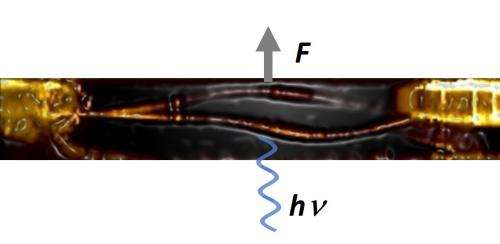Snap to attention: Polymers that react and move to light

Microvehicles and other devices that can change shape or move with no power source other than a beam of light may be possible through research led by the University of Pittsburgh. The researchers are investigating polymers that "snap" when triggered by light, thereby converting light energy into mechanical work and potentially eliminating the need for traditional machine components such as switches and power sources.
"I like to compare this action to that of a Venus flytrap," says M. Ravi Shankar, lead author of the study and associate professor of industrial engineering in the University's Swanson School of Engineering. "The underlying mechanism that allows the Venus flytrap to capture prey is slow. But because its internal structure is coupled to use elastic instability, a snapping action occurs, and this delivers the power to shut the trap quickly. A similar mechanism acts in the beak of the Hummingbird to help snap-up insects"
The research was performed by Shankar in collaboration with Timothy J. White of the Air Force Research Laboratory at Wright-Patterson Air Force Base and Matthew Smith, assistant professor of engineering at Hope College in Holland, Mich.
Focusing on this elastic instability, Shankar examined polymeric materials, prepared by researchers at the Air Force Research Laboratory, which demonstrated unprecedented actuation rates and output powers. With light from a hand-held laser pointer, the polymers generate high amounts of power to convert the light into mechanical work without any onboard power source or wiring. Specific functions would be pre-programmed into the material so that the device would function once exposed to a light source and controlled by changing the character of the light.
"As we look to real-world applications, you could activate a switch simply by shining light on it," Shankar says. "For example, you could develop soft machines such as stents or other biomedical devices that can be more adaptive and easily controlled. In a more complex mechanism, we could imagine a light-driven robotic or morphing structure, or microvehicles that would be more compact because you eliminate the need for an on-board power system. The work potential is built into the polymer itself and is triggered with light."
The study, titled "Contactless, photoinitiated snap-through in azobenzene-functionalized polymers," was published Oct. 30, 2013, in the early edition of the Proceedings of the National Academy of Sciences.
Journal information: Proceedings of the National Academy of Sciences
Provided by University of Pittsburgh



















